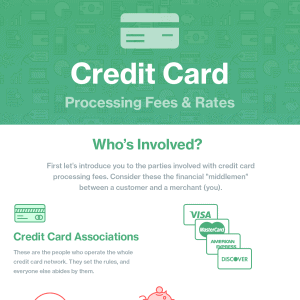Confused by cross-border fees on your processing statement? Here’s what triggers them -- and whether you can avoid them.
Our content reflects the editorial opinions of our experts. While our site makes money through
referral partnerships, we only partner with companies that meet our standards for quality, as outlined in our independent
rating and scoring system.
Credit card payments make sales easy, but the fees can get complicated. One of the trickiest is the cross-border fee — a charge for accepting cards issued outside your country. Let’s look at what it is, when it applies, why it’s charged, and how it affects your business.
What Is A Cross-Border Fee?
A cross-border fee is a charge that applies when a merchant in one country accepts payment from a card issued in another country.
It’s usually a small percentage (under 1%) of each sale and is set by card networks. Cross-border fees are non-negotiable.
When Does A Cross-Border Fee Apply?
Cross-border fees kick in any time the customer’s card and the merchant’s business are based in different countries. That can happen in two main ways:
Selling Internationally On Purpose
If you run an eCommerce shop in the US and start selling to customers in Canada, your payments have to be converted from Canadian dollars into USD. That extra work for the banks triggers a cross-border fee.
While it’s only a small percentage of each sale, it can add up over time and even influence whether expanding abroad makes sense.
Accepting International Cards Without Realizing It
Cross-border fees can also pop up in brick-and-mortar sales. For example, a tourist visiting the US might pay with a credit card issued by a bank overseas. Even though you processed the payment in USD, the transaction is technically international, so the cross-border fee applies.
Why Are Cross-Border Fees Charged?
International transactions require extra processing and sometimes carry higher risk, especially with unstable currencies. To cover these costs, card networks add cross-border fees.
Card networks like Visa and Mastercard charge cross-border fees to credit card processors. The processors then pass these fees to merchants.
When reviewing your processing statement, note that cross-border fees may be called something else. Visa calls its fee the International Service Assessment. Mastercard just calls it the Cross-Border Fee.
How Much Are Cross-Border Fees?
Exact rates vary depending on where the merchant is located and whether the transaction settles in U.S. dollars. Here’s a quick breakdown of what to expect.
| Card Network |
Scenario |
Fee |
| Mastercard |
Card issued abroad, settled in USD |
0.6% |
| Mastercard |
Card issued abroad, not settled in USD |
1.0% |
| Visa |
Card issued abroad, settled in USD |
0.8% |
| Visa |
Card issued abroad, not settled in USD |
1.0% |
Other network charges may also apply, such as Visa’s Global Acquirer Program Support Fee for U.S. merchants handling cards from abroad.
How Do Third-Party Processors Handle Cross-Border Fees?
Merchant account providers typically use transparent interchange-plus pricing, where card network fees and processor markups are listed separately.
On the other hand, third-party processors like Square and Stripe usually charge flat rates (e.g., 2.9% + $0.30 for online US sales). This keeps pricing predictable but less transparent. Processors absorb the differences across card types, so they often set their own pricing for cross-border fees instead of passing on the exact card network charges.
Not all processors even allow international sales. Square doesn’t, while PayPal and Stripe do, but add their own cross-border fees.
Can You Avoid Cross-Border Fees?
In most cases, you can’t avoid cross-border fees, since these are mandatory network assessment fees. Your processor shouldn’t profit from them, though some may add markups, so it’s worth checking your statements closely
Since you can’t avoid them, here are two things you can do:
- Negotiate with your processor to ensure they’re not layering on extra, unnecessary fees.
- If you have significant business in one foreign market, consider registering your company and opening a bank account there. This can reduce cross-border costs, but it’s only practical for larger operations.
The Bottom Line On Cross-Border Fees
Cross-border fees are just one of many costs that come with accepting credit cards. While you can’t avoid them entirely, you can plan for them. If international sales are part of your growth strategy, think of these fees as the cost of accessing a bigger customer base.
The key is to make sure you’re not paying more than you need to. Review your processor’s pricing, confirm how they handle cross-border transactions, and watch for any extra markups beyond what the card networks charge.
In most cases, that small percentage is a fair trade-off for the chance to reach customers across borders and grow your business.











